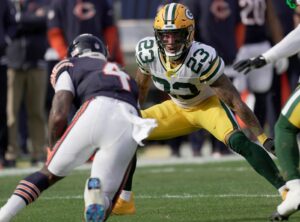Concluding the AFC East’s involvement in our newest installment, we take a look at what the New York Jets do on both sides of the ball.
The Breakdown: A Look at the New York Jets Schematic Philosophy
Spreading Things Out
Offensive coordinator John Morton enters his first season with the Jets having previously spent 2011-2016 as the wide receivers coach for Jim Harbaugh‘s 49ers (’11-’14) and Sean Payton‘s New Orleans Saints (’15-’16). Under previous coordinator Chan Gailey, the Jets were built on multiple-receiver spread formations, best exemplified by their league-leading use of four receivers in 2015. Spreading defenses out like such forces the opposition to widen with you-an aspect I’ve touched upon earlier in this series-and ultimately intensifies their ability to disguise blitzes and coverages. Such increased spacing further establishes clear-defined throwing lanes that significantly reduces the amount of calculated risks you ask your quarterback to take.
Going four-wide and detaching all eligible receivers with such regularity also means you’re only left with the potential of having six-man protection if you’re not opting to release the running back or tight end down the field. As a result, the system is designed to get the ball out on time which mitigates the necessity for elite pass protectors. When you operate in a system that asks the ball to be released quicker than usual, a much heavier emphasis is placed on the quarterback’s decision-making before the snap which is why it was strange to see former quarterback Ryan Fitzpatrick struggle at his 2016 rate.
These aspects were also the foundation of the Saints passing game that thrived on attacking defenses vertically, particularly with a seam route from the slot. New Orleans was also a fan of versatility from the receiver position, likely the catalyst for the Jets selection of Chad Hansen and ArDarius Stewart and the signing of undrafted guys Gabe Marks and KD Cannon this past April. The Saints use of multiple formations and pre-snap movement plays into the hands of their pass-catching personnel, as well as versatile running back Matt Forte. Payton loved to line former running backs Reggie Bush and Darren Sproles along the formation to create offensive mismatches and leverage issues for the defense.
The Jets have replicated this and will continue to do so, relying on Forte’s skills as a receiver to play an integral role in their four-wide sets yet again due to the amount of times he’ll see a linebacker across from him. While they’re not of the same caliber, having a movable tight end in Jordan Leggett will allow Morton to devise responsibilities similar to what he did with Jimmy Graham, whether it be flexing him out as an iso-option or keeping him in the slot. Morton’s time with the Saints should replicate the foundation of the 2016 Jets system with added wrinkles to mask the lack of talent at quarterback.
Pressure and Aggression
Much like we discussed with the Patriots, the Jets defensive fronts are fluid and adaptable based on the opponent. While they operate out of a base 3-4, head coach Todd Bowles isn’t averse in the slightest to shuffling his unit around due to the talent he has up front. He employs a multitude of different fronts on first, second and third down depending on the opponent. These three down guys occupy base protection to create free rush lanes in his blitz-heavy scheme, particularity right up the middle where, via twists and stunts that fracture the interior in these blitzes, his athletic down linemen can capitalize on the athleticism advantage. It’s also the quickest, most efficient path to the quarterback and forces the running back to be accurate with his steps.
As the defensive coordinator for the Arizona Cardinals in 2014, Bowles paced the league in both dime and seven defensive back packages. When you blitz as often as Bowles prefers, talented defensive backs that can win one-on-one matchups are a requirement which is also the conundrum Bowles faces. He employs a healthy amount of man-free and cover 0 looks that place a hefty amount of responsibility on his defensive backs to be right. But towards the end of last season, he shifted to more zone looks because that previous level of trust diminished. When you have five or more defensive backs on the field at once as often as the Jets do, linebacker is no longer the same premium-hence why they have the level of talent they do at the position. Their base 3-4 calls for those stand-up defenders to set an edge against the run and get to the quarterback against the pass rather than handle coverage duties.
Many were perplexed when New York spent their first two selections in the NFL Draft on safeties Jamal Adams and Marcus Maye. That said, it becomes more reasonable when you consider Bowles’ use of defensive backs and factor in that former safety duo Marcus Gilchrist and Calvin Pryor were a serious liability and ultimately relieved of their duties. Putting three safeties on the field, a Bowles staple, provides a litany of disguised blitzes and rotations while still allowing his defensive line to put pressure on the quarterback. The Jets also bring in corner Morris Claiborne and double dipped in the draft at the position, selecting Jeremy Clark and Derrick Jones. Both face an uphill battle to make the 53 man roster as sixth round selections, but it shows the commitment to finding quality man coverage defenders. Expect Adams to quickly become a household name in that system as an athletic safety who can blitz and man the middle in coverage.






